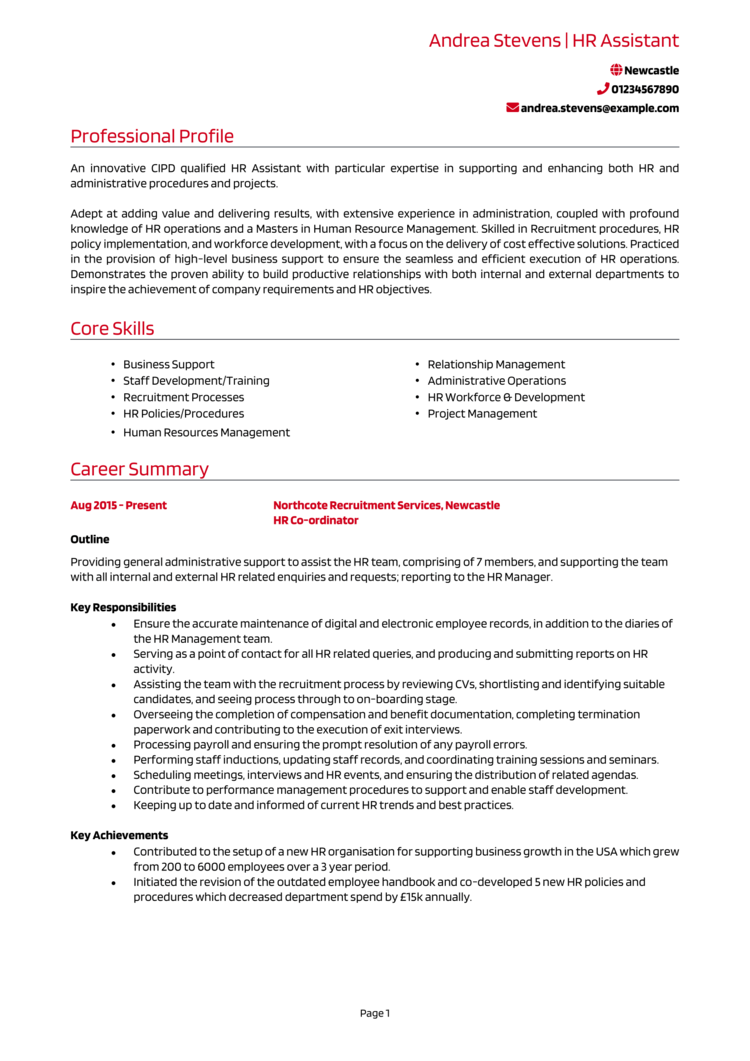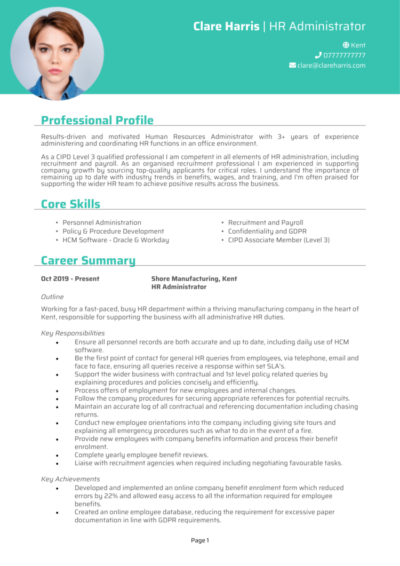As an HR Administrator, you’re the organisational glue that keeps entire departments together.
But to land your next HR role, your CV needs to demonstrate your understanding of HR processes and your ability to support both employees and management effectively.
With 4 HR administrator CV examples, this guide will help you craft an application that highlights your administrative expertise, HR knowledge, and organisational skills, helping you stand out in the hiring process and land your next role.
HR Administrator CV

Entry Level HR CV

HR Assistant CV

HR with No Experience CV

How to write your HR Administrator CV
Discover how to craft a HR Administrator CV that lands interviews with this simple step-by-step guide.
This guide will walk you through building a CV that highlights your administrative skills, HR processes knowledge, and your ability to work accurately and efficiently. Whether you’re experienced or entering HR from an administrative background, you’ll learn how to present yourself as the ideal HR Administrator.
Structuring your HR Administrator CV


An effective HR department depends on structure and organisation – your CV structure should follow the same principles. Hiring managers need to quickly see your administrative strengths, HR expertise, and technical know-how without digging through unnecessary details.
Here’s the layout a good CV should follow:
- Name and contact details – Place personal details at the top so employers can get in touch easily.
- Profile – Give a brief summary highlighting your HR expertise, administrative skills, and understanding of HR processes.
- Core skills – Highlight your key abilities, from data management to employee support.
- Work experience – Walk through your HR roles, focusing on administrative duties, HR software proficiency, and process support.
- Education – Go through the relevant qualifications, HR training, and degrees which underpin your expertise.
- Additional info – Optional, but this could include professional memberships, awards, or hobbies.
How should you format your HR Administrator CV?


If a hiring manager can’t skim your CV and see the essentials straight away, it’s going to the bottom of the pile. Your CV format should reflect the professional standards expected in HR – clear and professional. When you’re writing a CV, remember that HR managers will expect to see well-organised sections and easy-to-scan information, free from mistakes.
To keep your CV looking professional, follow these tips:
- Bullet points – Use bullet points to break down responsibilities and achievements for quick reading.
- Divide sections – Clearly label each section so nothing gets overlooked.
- Use a clear and readable font – Stick to professional and clean fonts, and a sensible colour scheme.
- No more than 2 pages – Keep it concise to maintain their interest while still covering all the essentials. This is the right length to achieve that.
Creating a strong HR Administrator profile


Your CV profile is your chance to introduce yourself as a capable HR Administrator. This section should give hiring managers a quick snapshot of your administrative strengths, HR knowledge, and your ability to support a busy HR department.
It’s the first thing they’ll read: if it doesn’t catch attention, they won’t even make it to your impressive spreadsheet skills.
HR Administrator CV profile examples
Profile 1
Detail-oriented HR Administrator with four years of experience in recruitment coordination, employee records management, and HR compliance. Skilled in handling payroll administration, onboarding processes, and benefits management. Proficient in HR software such as Workday, BambooHR, and SAP. Committed to supporting HR functions and ensuring a positive workplace environment.
Profile 2
Organised and proactive HR Administrator with three years of expertise in employee relations, HR documentation, and policy implementation. Adept at coordinating recruitment processes, managing confidential records, and assisting in training and development programs. Experienced in working with HR databases and employment law compliance. Passionate about improving HR processes and employee engagement.
Profile 3
Experienced HR Administrator with over six years of expertise in HR operations, employee onboarding, and compliance management within fast-paced corporate environments. Skilled in processing payroll, maintaining HR databases, and supporting performance review cycles. Proficient in using HRIS systems and employment law knowledge to ensure smooth HR operations. Dedicated to fostering a productive and inclusive workplace.
Details to put in your HR Administrator CV profile
Here’s what to include in your profile:
- HR administration experience – Briefly mention your years of experience and the types of companies you’ve worked for.
- Key HR processes supported – Reference areas like onboarding, employee record management, and payroll assistance.
- Attention to detail – Emphasise your ability to maintain accurate records and handle confidential information professionally.
- HR software proficiency – Mention any HRIS systems or payroll software you’ve used.
- Strong communication skills – Highlight your ability to liaise effectively between employees and management.
Presenting your core skills


This is your HR skills checklist – everything the hiring manager needs to know you can handle. Showcase the core abilities that make HR run smoothly – from data accuracy to staying GDPR compliant. It’s a quickfire way to show you’ve got the core competencies to excel in the role – perfect for time-pressed recruiters scanning applications.
Because every HR role can vary, tailor your CV skills section to the specific job you’re applying for. Focus on the skills most relevant to the employer, whether that’s data management, compliance, or employee communication.
Essential skills that recruiters look for in a HR Administrator CV
- Employee Records Management – Maintaining accurate and up-to-date employee records, contracts, and HR documentation.
- Recruitment Support – Assisting with job postings, candidate screening, interview scheduling, and onboarding processes.
- Payroll and Benefits Administration – Managing payroll data, leave tracking, and employee benefits programs.
- HR Policy Implementation – Ensuring company policies and procedures are communicated and adhered to by employees.
- Compliance and Employment Law Knowledge – Ensuring HR processes align with legal regulations, GDPR, and company policies.
- Training and Development Coordination – Organising employee training sessions, workshops, and professional development initiatives.
- Performance Management Support – Assisting with appraisals, feedback collection, and employee engagement activities.
- HR Software and Database Management – Using HRIS systems such as SAP, Workday, or BambooHR to manage employee data.
- Conflict Resolution and Employee Relations – Supporting HR teams in handling grievances, disputes, and workplace concerns.
- Administrative and Office Support – Managing HR correspondence, drafting reports, and coordinating HR projects.
How to highlight work experience


Your work experience section should demonstrate how you’ve applied your administrative skills and HR knowledge in practical settings. Every HR department needs someone who can keep calm when paperwork piles up – this is your chance to prove you’re that person: HR managers want to see how you’ve supported processes and helped keep HR operations running smoothly.
Begin with your most recent role and work backwards. For each position, show the HR processes you supported, the systems you used, and how your attention to detail made a difference.
How to make your past experience easy to read for employers

- Outline – Give a quick overview of the company, its size, and the HR team you supported.
- Responsibilities – Describe your administrative duties, including managing employee records, assisting with recruitment, and coordinating onboarding processes. Use power verbs like “maintained,” “coordinated,” and “supported.”
- Achievements – Mention improvements you helped implement, such as streamlining document processes, introducing new filing systems, or reducing onboarding times.
Example job entries for HR Administrators
HR Administrator | Evergreen Financials
Outline
Within the HR department of a leading UK financial services firm, managed HR administrative tasks, employee records, and recruitment coordination.
Responsibilities
- Maintained and updated employee records, ensuring accuracy and compliance with GDPR regulations.
- Coordinated the onboarding process, preparing contracts, conducting inductions, and assisting new hires.
- Processed payroll and benefits administration, liaising with finance teams for accurate salary payments.
- Supported the recruitment process by posting job ads, scheduling interviews, and communicating with candidates.
- Assisted in drafting HR policies and ensuring adherence to employment laws and company procedures.
Achievements
- Reduced payroll processing errors by 20 percent through improved data verification procedures.
- Streamlined the onboarding process, decreasing new hire paperwork completion time by 30 percent.
- Recognised for improving HR documentation processes, enhancing compliance and efficiency.
HR Administrator | Michaelsen Manufacturers
Outline
For a multinational manufacturing company, provided administrative support to the HR team, ensuring smooth employee lifecycle management.
Responsibilities
- Managed employee documentation, including contracts, appraisals, and absence records.
- Coordinated training and development sessions, assisting in scheduling and materials preparation.
- Handled HR queries from employees, providing guidance on policies, benefits, and procedures.
- Supported performance management processes, tracking appraisals and probation reviews.
- Maintained HR databases, ensuring up-to-date and accurate information on employees.
Achievements
- Improved efficiency by implementing a new HR filing system, reducing document retrieval time by 50 percent.
- Supported the HR team in rolling out a new employee benefits scheme, increasing participation by 25 percent.
- Received positive feedback from staff for clear communication and support in HR-related queries.
HR Administrator | NuTech Solutions
Outline
Within the HR team of a global technology firm, provided administrative and operational support to facilitate HR processes.
Responsibilities
- Processed new hire paperwork, ensuring compliance with legal requirements and internal policies.
- Assisted in employee relations matters, documenting grievances and disciplinary actions.
- Managed recruitment logistics, including job postings, interview scheduling, and candidate follow-ups.
- Updated HR reports and dashboards, tracking employee turnover, absence rates, and performance data.
- Organised employee engagement initiatives, including wellness programs and company events.
Achievements
- Reduced recruitment lead time by 25 percent by improving interview scheduling efficiency.
- Enhanced employee engagement by coordinating successful workplace wellness initiatives.
- Implemented an automated leave tracking system, reducing administrative workload by 40 percent.
Education and qualifications


Your education section should highlight qualifications related to HR, business administration, or office management. For HR Administrator roles, formal HR qualifications can be a great advantage, but experience is the priority: so keep your education section nice and concise.
Include your degree, diploma, or any relevant certifications, especially those from recognised bodies like CIPD. If you’ve taken additional HR courses, such as employment law or payroll processing, be sure to mention them.
Qualifications recruiters look for in a HR Administrator
- CIPD Level 3 Certificate in People Practice – A strong entry-level qualification for HR professionals.
- Level 3 Diploma in Business Administration – Relevant for the administrative side of the role.
- Payroll Administration Certificate – Useful for HR roles with payroll responsibilities.
- Employment Law Fundamentals Certificate – Valuable for demonstrating your understanding of compliance.
- HR Software Training Certification (e.g., HRIS Systems) – Highlights technical proficiency often needed in modern HR roles.





